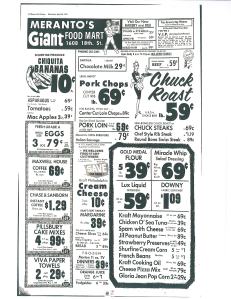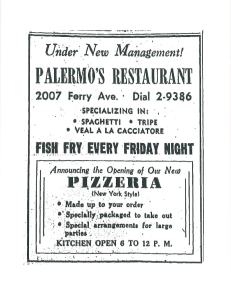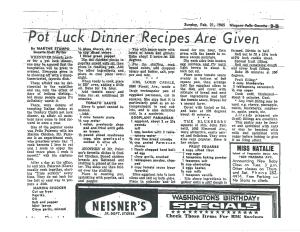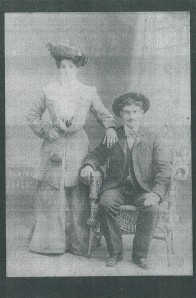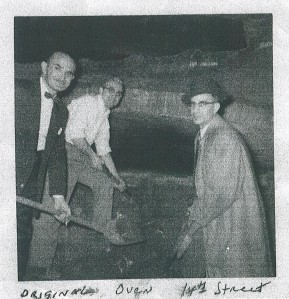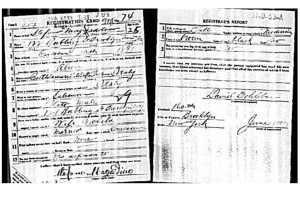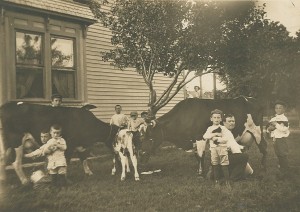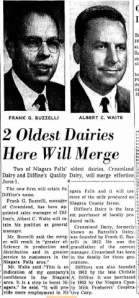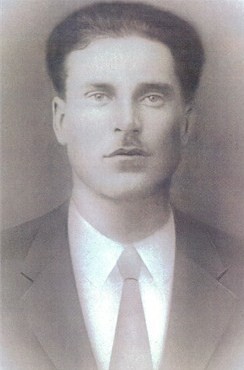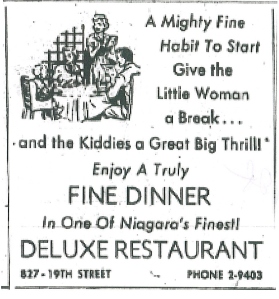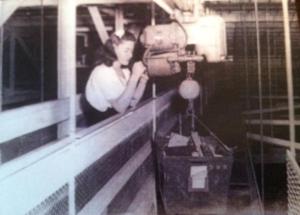Written by Eleanor “Ellie” Migliazzo Novara
(Click on images to make larger)

When I began researching my Migliazzo family history, I grew up knowing only one family who were my father’s first cousins, living in Niagara Falls, as the rest of the Migliazzo relatives lived in Italy. To my surprise, I came across a few cards from a family in Arizona who occasionally wrote to my parents expressing that they missed us and always wished our family well during the holidays. I learned that this family was my father, Rocco Migliazzo’s, first cousins who were twins, Giovanni (John) Migliazzo and Antonio (Anthony) Migliazzo [along with Anthony’s wife Josephine (Govannini) and young son Bruno]. My sister, Connie (Migliazzo) Paolone, remembers the twins, who were born on August 5, 1893 in Girifalco, Catanzaro Calabria Italy, and to her knowledge they later left Niagara Falls for Arizona due to health reasons.
The twins, as they were referred to, were partners in a well-known and prosperous business that opened in or around 1934 in Niagara Falls, namely: MIGLIAZZO and MERANTO CITY MARKET [also known as the M and M City Market]. Connie recalls that our father Rocco also helped his cousins with the business for a brief period of time. Not knowing much about the business or the Migliazzo twins, my research consisted of seeking out a few of the Meranto family members, and this is where my story begins…..
I interviewed Elaine Meranto, daughter of Nicholas and Mary Meranto. Nicholas was also associated with M and M City Market. Elaine did remember the twin brothers, but didn’t know much about them and knew they were not her relatives. At various holidays, especially Easter, Elaine remembers the large display of flowers and baby chicks and recalls the big snowstorm in 1936. She did find photos of the market along with various family members and many employees of the market. I am grateful to Elaine for copies of these photos and taking the time to talk and tell me that her cousin, Ralph Meranto, would be the person with more knowledge about the market.

Off I went to the Main Street Library in Niagara Falls to meet with Ralph where I picked his brain for information and learned that there were actually two different market businesses that had eventually merged into one. Sure enough, Ralph was a great source of information.
Ralph and Elaine’s grandfather, Salvatore “Sam” Meranto, born on December 24, 1882, in Catanzaro, Calabria Italy and his wife, Mary (Talarico) Meranto raised a family of three boys and two daughters on their farm in Lewiston, NY. As a farmer Salvatore sold produce to various wholesale businesses in Niagara and Erie Counties. In 1919 he became the founder of the “original” Meranto Meat Market located in the Niagara Falls City Market.
Ralph believes his father, Thomas Meranto, must have inherited his father’s genes for the produce business. [Maybe because of all the children born to Salvatore and Mary he is the only child born in Italy while they were on vacation visiting their family]. In 1929 he formed a partnership with Giovanni (John) Migliazzo in the Migliazzo and Meranto City Market (aka M and M Market), where they sold fresh fruits, vegetables and meats, with Carmen Granto, Sr. as Manager. The market was located at 1800 Pine Avenue, Niagara Falls, NY. Others involved in the business were Nicholas Meranto, and Anthony Migliazzo.
Later, Carmen Granto, Sr., Thomas Meranto and Nicholas Meranto, (Nicholas’ wife Mary F. (Critelli) Meranto was the bookkeeper) opened a grocery/meat market [also known as the G and M Giant Market] located at 740 – 19th Street, Niagara Falls, NY. Eventually both businesses worked together closely as one market.
When Ralph was around 10-years old, he remembers his father bringing him into the business and said it was “because he knew how to read.” This is where he learned that there was always an orderly way for arranging
each grouping of produce on the tables. The most commonly used method was to place the many fruits on the tables in the shape of a pyramid; vegetables were laid out overlapping each other in a long row horizontally or vertically and large squash, pumpkins, etc. also had their own sequence of design to help appeal to the customer. Employees would trim lettuce, celery, broccoli, etc. and throw the trimmings on the floor. It was Ralph’s job to sweep everything up.
Another job Ralph was given was to fill large bags with potatoes. He would open the bag, insert a large funnel and then fill the bags to the top, then slip the funnel up and out the top of the bag. The bags were then placed on a table for display and left opened for customers to purchase.
One comical memory is the “watermelon” ritual. A chain gang of employees would unload the trucks by transferring each watermelon from one person to another. When the final watermelon was handed to the last person, it would purportedly fall to the floor, allowing the employees to scramble for a refreshing slice along with lots of laughter.
Ralph told me he especially remembers enjoying working along with John Migliazzo and Carmen Granto, Sr. and how they “took him under his wing” teaching him the produce/meat business. One thing that came to his mind, John was always worried whether he had eaten by telling him “If you get hungry just take some fruit and eat – you don’t have to ask just take something.”
By the time Ralph was 14-years old the market had moved and more or less merged with the G and M Market which was next to the M and M Market in the City Market. The two businesses primarily sold produce and meat. Both of these businesses, known as “vendors”, had to apply for a permit to do business by renting a “stall with a number.” These stalls were located in the City Market of Niagara Falls and each year they were required to renew their permit.
The M and M Market and G and M Market ran various ads in the Niagara Falls Gazette, especially for fundraisers or a newly opened business. Some of their ads were as follows, “BEST WISHES FROM MIGLAZZO AND MERANTO, FRESH FRUITS, VEGETABLES AND MEATS, 1800 PINE AVENUE AT CITY MARKET” and “SUCCESS IS OUR WISH To the new HIPPODROME THEATRE G&M Giant Food Market, 740 19th STREET, On City Market Square.”
According to Ralph, Thomas Meranto was named Temporary Chairman of the First Independent Food Dealers meeting of Niagara Falls in December 1946, in the Chamber of Commerce building to complete plans for organization of an Independent Food Dealers’ Association. Invitations were sent to several food dealers in Niagara Falls to attend. Thomas said “the meeting is open to all independent grocery and meat dealers in the city, whether or not they receive an invitation.” Thomas, thereafter, became the Chairman of this newly formed association. This association grew to be known as the now existing Pine Avenue Business Association.
Well I guess the “apple doesn’t fall far from the tree” because Ralph worked in various markets prior to going into business with his father. In 1958, after Ralph graduated from the University of Buffalo, he and his father opened their own business. The business services were expanded to include wholesale foods of every phase of social and business activities. Their first endeavor was the frozen goods service that extended to sales of large quantities which must have been one of the first markets in Niagara Falls to sell this large a quantity of frozen foods. This business was located on Portage Road, and continued until the Meranto Meat Market moved in 1971 to 1608 – 18th Street, Niagara Falls, NY.
The growth of the Meranto Meat Market that prospered for over 55-years was attained through the families’ devotion to serving the public with quality service.


Following my interviews with Elaine and Ralph, it was time to contact Cynthia (Granto) Bianco for more information on the Migliazzo, Granto and Meranto Giant Market, particularly since her father, Carmen Granto, Sr., born on January 26, 1906, in Calabria, Italy was a partner. Another hard working Italian who emigrated to the United States and joined fellow Italians to form an even bigger city market complex.
Celia (Simone) Granto, Cynthia’s mother, a delightfully 93-year young and beautiful woman, who is the last of the original owners of the business, joined us for the interview. She appears to have lived a long and healthy life. She happily reminisced that she worked for the G & M Giant Market as a cashier where she met and married Carmen on January 3, 1942. This little story brought a twinkle to her eyes. Carmen and Celia raised two children, their son Carmen Granto, Jr. and Cynthia.
Cynthia was familiar with many of the same employees who continued on when the Granto and Meranto Giant Market was formed, so it was, she says that the many employees and others associated with the market, like John Migliazzo and Nicholas Meranto.
Her great enjoyment was working for her father and as she sits back in her chair begins to tell me that one of her favorite memories of special times spent with him was when “after school each day I would wait on the stoop of my home and look down the street to watch for my father… upon seeing him returning home from work, I would run down the street to meet him and he would catch me in his arms and swing me around and we would both walk home.”
Another pleasant memory was when Carmen invited her to ride with him to Buffalo to purchase the produce. They would leave at 4:00 a.m. which seemed like forever to get there, as in those days there were no thruway systems in the area. It was an exciting outing as Buffalo was a bustling city. It had become a ritual that after the Buffalo trip on the way home they would stop for breakfast at a restaurant not far from the market. Already the early morning start was beginning to feel like they had been out all day, especially after their breakfast.
They would return around 6:00 a.m., the truck filled with a variety of produce. Just as Ralph had expressed earlier, Cynthia has vivid memories of how the hard work really began as all the produce had to be cleaned, trimmed, organized, and ready for the customers to arrive for the day’s business. These were “very long hard working days.” Mixed in were happy times as well. As a matter of fact, Cynthia remembers the comical “watermelon ritual” along with the arrangement that went into the “displaying of the fruits and vegetables,” the same as Ralph described.
When she became older, Cynthia recalls helping her father with more advanced jobs. He taught her how to count the day’s receipts efficiently so that all the bills were facing one way and stacked in proper order to bring to the bank.
Cynthia, like Elaine, enjoyed the vast variety of flowers that were for sale: hydrangeas, lilies, tulips, dahlias, etc. They were very romantic and made the market look like a huge flower garden.
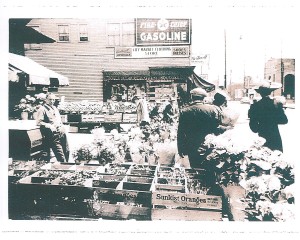
Christmas was always special to Cynthia when the Niagara Falls city workers would arrive with a large Christmas tree for display in front of the market. Celia remembers that the market had a special area set aside for selling Christmas trees. Each year field trips were arranged for schools to bring the children to visit the market and the trees.
Cynthia and Celia remember all the hard work required to make the market a success. Carmen will always be remembered as a wonderfully kind man who, according to Cynthia would feed anyone in need and if they didn’t have enough money to pay their bill, he would take what they had and they went off with their bag of groceries. In time the market began selling more merchandise other than produce and meat.
It appears that the Migliazzo, Meranto and Granto families were the precursors for what we now know as a “Supermarket.”
I was so proud to learn that two of my immigrant ancestors along with other immigrant families came to America and together developed these market businesses in Niagara Falls.
Reference:
Fulton, NYWebsite – Search Over 25,084,000 Old New York State Historical Newspaper Pages



